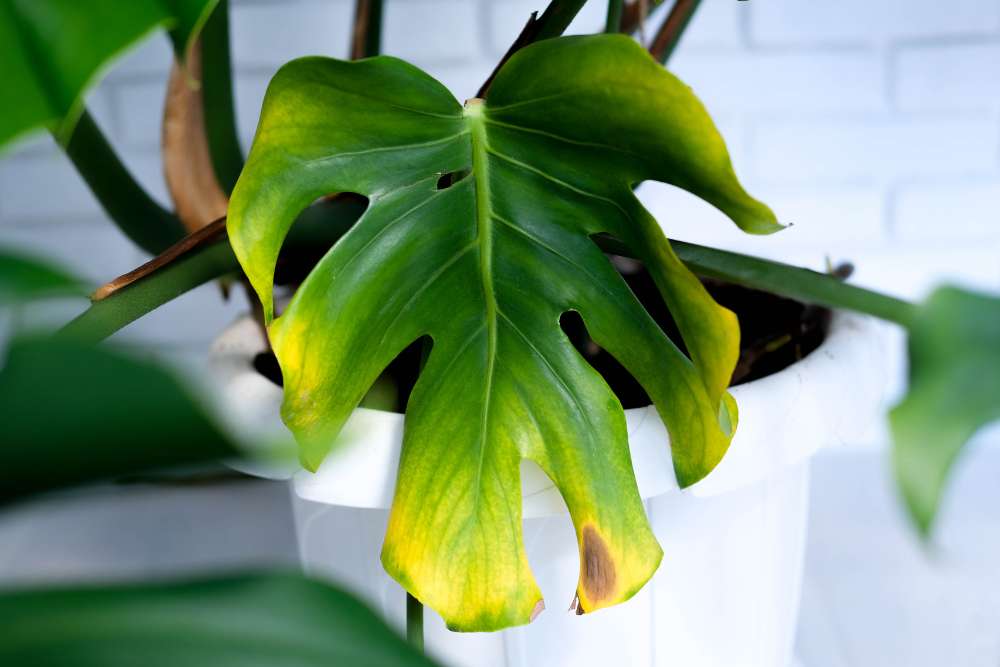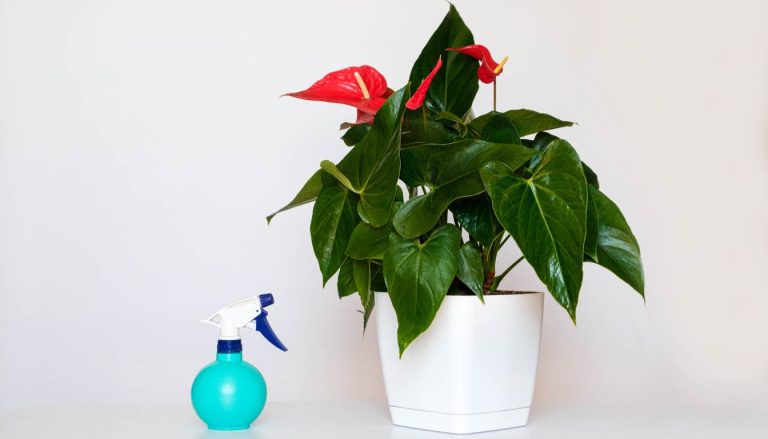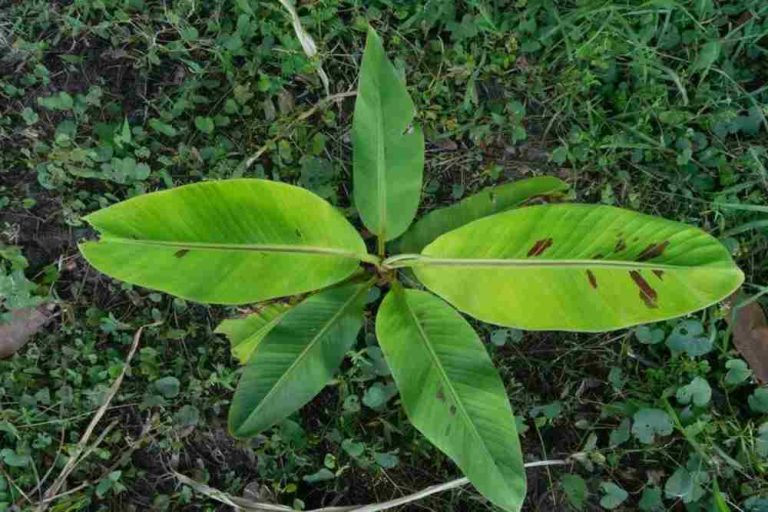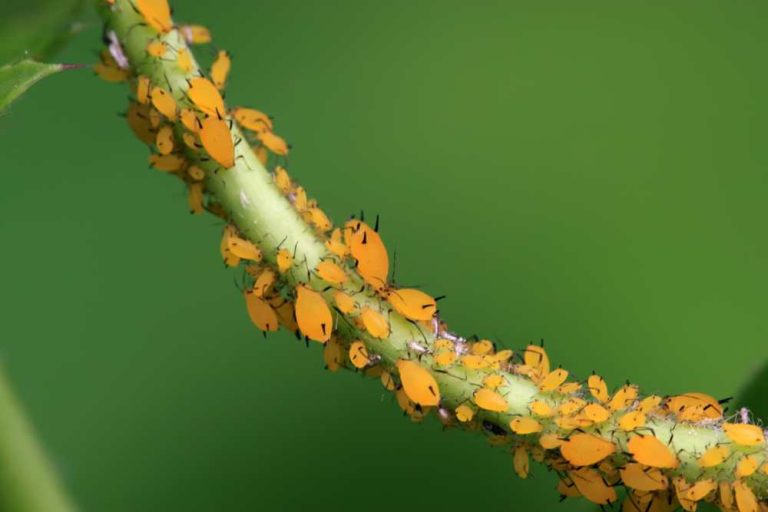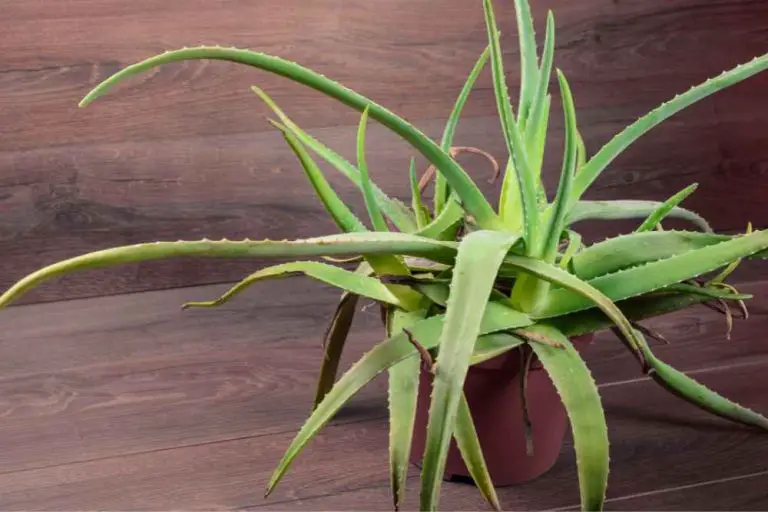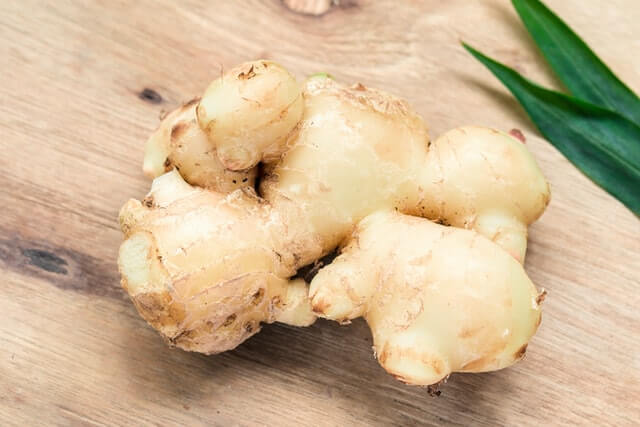10 Signs Of Monstera Leaf Spot Disease: Causes, Symptoms, and Treatment
Monstera is a well-liked genus of indoor plants with fascinating leaves and stunning patterns. Since they are prized for their foliage, it can be upsetting when it starts to deteriorate and fall off, signaling a significant growth issue. Therefore, it is understandable to be concerned if your monstera plant has developed brown or black spots on its leaves.
The development of leaf (brown or black) spots on your Monstera can occur for various reasons, including improper maintenance, poor environmental conditions, pests, and diseases. This article will review some of the more typical reasons that Monstera plants get brown spots and what to do if you discover Monstera leaf spot disease on your plants.
To prevent your plant from dying from an unrelated condition while you try to find the cause, you should take care of the symptoms as soon as possible. You can keep them healthy and prevent this disease by routinely watering your Monstera plants with clean water only when necessary, providing them with appropriate light, and maintaining a clean environment.
Fungal Leaf Spot Monstera Or Bacterial Infection
Diseases caused by bacteria or fungi can cause the browning of monstera leaves. If you look carefully, you may notice various black spots resembling speckled patches and may appear to be little leaf holes.
Monstera is susceptible to bacterial and fungal infections when kept in excessive moisture or grown in continually moist soil. A plant of the same species may infect another plant if proper care is not taken to maintain it. Treating the brown spots on Monstera leaves as soon as possible in this circumstance is even more essential to prevent the further spread of the spots.
What Distinguishes Bacterial Leaf Spot From Fungal Leaf Spot?
It can be challenging to distinguish between bacterial and fungal leaf spots. It is so challenging that most gardeners don’t even bother attempting to identify the fungus or bacteria responsible for the issue. Since the symptoms of the two diseases are identical, they share a common cause in some situations.
The production of spores by fungal leaf spots is the only significant distinction between them. This depends on the type and size of the houseplant. The primary causes of fungus leaf spots are dusty plants and unclean surroundings. Additionally, inadequate ventilation and an environment with too much humidity can lead to fungal diseases. On the other hand, bacterial infection occurs only when you come into contact with infected soil or water.
The good news is that both bacterial and fungal leaf spots can be treated and prevented using the same methods.
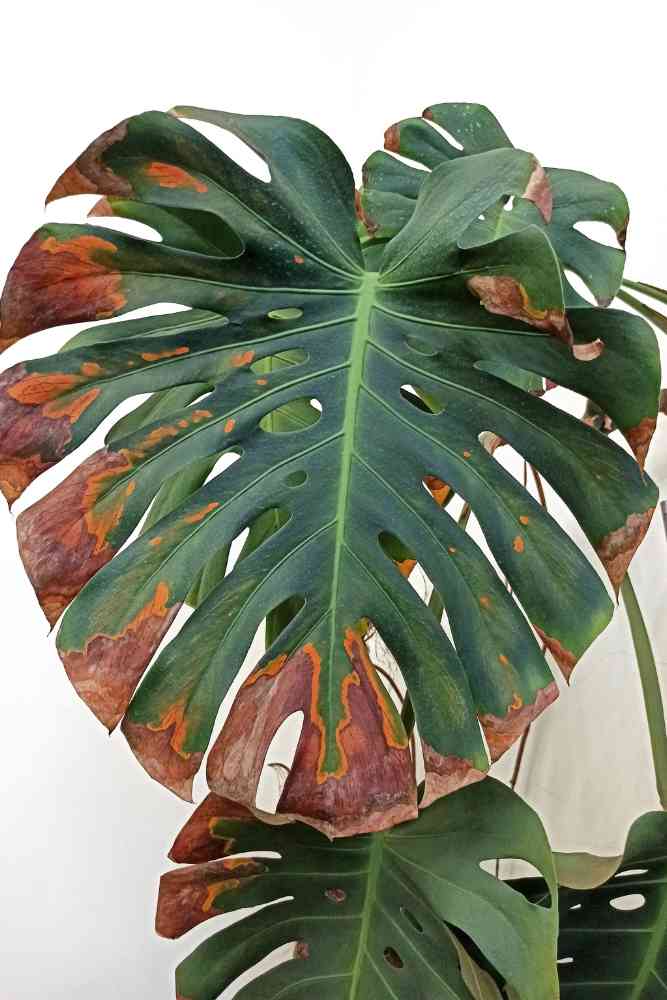
- Yellow Halo Surrounding Spots
- A yellow halo may also surround bacterial leaf spots. However, not all bacteria-caused spots have that halo, and many can develop without it.
- The Leaves May Develop Soft Rot
- Bacterial leaf spots can occasionally cause the leaves to soft rot. This can emerge in the center of the leaf or at the tip of the leaf and expand upward. Unfortunately, some fungi can also transmit infections and cause similar soft rot.
- The Presence Of Spots
- Compared to fungal leaf spots, bacterial leaf spots typically appear more angular. However, this isn’t a strict guideline.
How To Treat Fungus-Induced Leaf Spot On Monstera
When a fungus or bacteria infects your Monstera plants, you must remove any affected leaves and ensure the area around them has good air circulation. You must cut off infected leaves from your plant using sterile clippers or scissors.
The leaves should be placed in a plastic bag that has been sealed before being disposed of in the garbage container. It is essential to remove plant waste and leaves that have fallen from the plants from the surrounding environment. To ensure that your plants get enough oxygen, provide enough space to circulate air around them.
What Causes Monstera Bacterial Leaf Spot?
Pseudomonas cichorii is the principal bacterium in charge of leaf rusts or spots. Any Monstera species, such as your Monstera adansonii, deliciosa, obliqua, siltepecana, etc., are susceptible.
Monstera leaves occasionally have dark spotting. On Monstera, this condition is known as Bacterial Leaf Spot. Infections caused by fungi are not like bacterial infections. Using fungus treatment techniques won’t help your plant recover. This disease flourishes in warm, humid situations with little exposure to light.
It can be brought on by overwatering the plant, repeatedly exposing it to outside environments, blocking light by keeping it in a dark area, or other environmental variables. Black patches that eventually turn brown as they age are caused by bacteria that enter the plant through wounds on the plant’s leaves and stems.
If you’re not careful, brown spots on a monstera leaf could develop into unsightly brown blotches that make your plant appear messy, unpleasant, and unkempt. However, there are techniques to treat these brown patches before they worsen.
1. Pseudomonas Leaf Spot And Blight
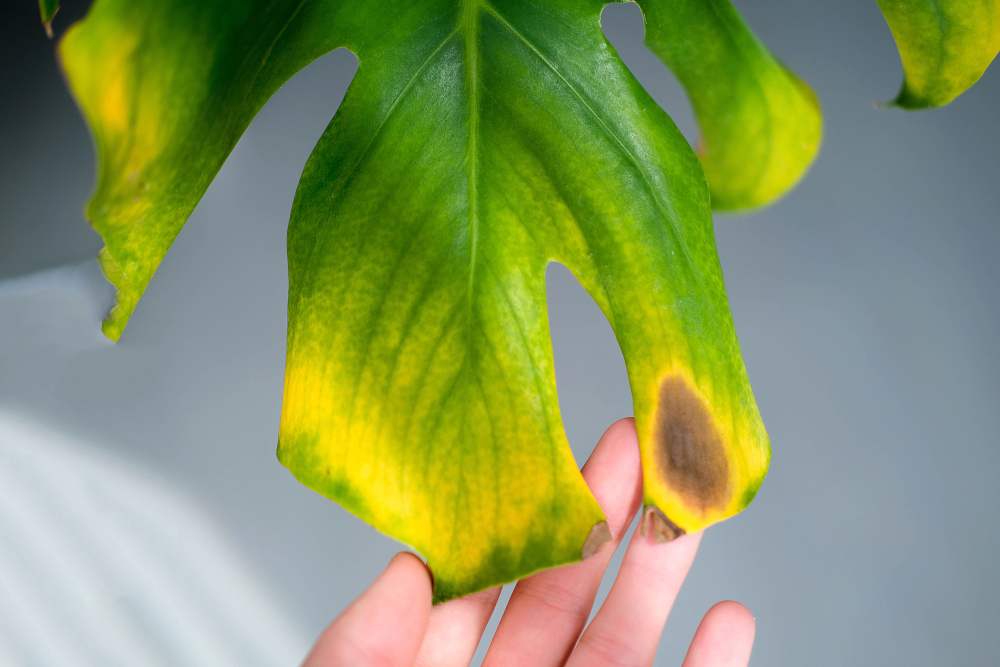
Pseudomonas cichorii is one of several species of Pseudomonas bacteria that can result in leaf spots or rust on Monstera plants. Though it can infect any leaf area, it frequently occurs on the margins. Pseudomonas infections begin as little, water-soaked patches that swiftly grow in size and turn dark brown or black.
Concentric rings of darkness and light will be visible, and a yellow halo might surround them. Lesions could be asymmetrical or round. However, they are not just found in interveinal areas. Often tan in color, their centers will become brittle if you allow them to dry up. Your plants pick up the Pseudomonas bacterium through cuts or hydathodes; misting will only worsen the problem.
Also, it benefits from higher temperatures between 82 and 85 °F (28 and 29 °C), but this effect reduces as the temperature rises. Finally, it can be spread by using contaminated tools, handling infected plants, and splashing water or insects.
2. Xanthomonas sp.
It begins as a little water-soaked leaf spot and becomes more severe on the lower leaf margins, but it is not a frequent issue with Monstera. When they die, it enlarges inward and goes yellow before turning brownish or reddish-brown.
Since veins prevent the lesions from growing, they could develop an angular appearance and a yellow halo. Through wounds, stomata, or leaf margins, Xanthomonas bacteria can enter plants via hydathodes. It spreads through infected utensils, water splashing, dirty hands, insects, or soil.
3. Erwinia sp. (Spots, Rusts, Stem, and Root Rot)
The genus Erwinia can produce soft rot. It could impact stems or roots or result in leaf rusts or spots. The species involved determines everything. Water-soaked yellow to brown lesions with a dispersed chlorotic halo is one of the symptoms of Erwinia sp. infection.
The spot may quickly expand, appear slimy, and even smell bad while appearing irregular under high temperatures and high humidity. Additionally, it could appear asymmetrical with deep tan centers and a dark brown border before the yellow halo. There might be a hole created if the centers collapse. Your Monstera leaves may turn yellow, wilt or droop, fall off, and exhibit stunted growth, among other symptoms, if it damages the roots.
In dry temperatures, Erwinia sp. causes lesion enlargement and causes the leaves to become papery, brittle, and yellow to tan in color. Finally, this bacterial disease prefers warm temperatures ranging from 71°F to 93°F (22°C to 34°C) as well as high humidity or temperature. It spreads through insects, contaminated hands, equipment, tools, splashing water, or both. Additionally, it can remain in the soil and spread infection.
How Can I Tell If My Monstera Has Bacterial Leaf Spot?
Examining the monstera leaves is the best technique to determine whether the plant is infected. Examine the top and bottom of each leaf. Remember to look for bacterial infections in the stems. The primary signs of a monstera bacterial spot are listed below.
- Leaves With Dark Spots
- The monstera leaves have numerous dark stains, which are typical symptoms of bacterial leaf spots. Usually, these patches become visible first when something is wrong with the Monstera.
- Sizes Of Spots Vary
- The patches that develop are erratic and range in width from 3/16″ to 1/2″. The dots may be rounded or more atypical in shape.
- Spots With Haloes Of Yellow
- Some spots you observe could have a golden halo around them and be brown.
- Collapsing Leaves
- The disease will eventually cause the infected leaves to fall off. On the soil surface of the Monstera, you might notice one or more infected leaves. As soon as you can, remove and discard these leaves.
- Discoloration Of The Leaves Edges
- You may also see discolored margins on your leaves. This generally happens after the spots emerge on the leaves.
- Unpleasant Odor
- Bacterial leaf spots can make the Monstera smell bad. As the disease spreads, the plant may emit an odor that may be musty or similar to decaying leaves.

- Water Soaked Areas
- Water-soaked leaves may also start to develop spots, though these are more common on older leaves.
- Oozy Leaf Spots
- A sticky bacterial fluid may start to flow out of the patches that develop on the leaves. There’s a chance that this will happen, and if it does, it might show up on both existing and new sites.
- Leaf Spots Cluster Together
- The leaf spots may begin to enlarge and group together when the plant is exposed to excessive moisture. This may cause large areas of the leaves to look like one enormous spot.
What Can Be Done To Stop Bacterial Leaf Spot On Monstera?
It can be challenging to eradicate when a bacterial leaf spot infects a Monstera plant. Because of this, stopping bacterial leaf spot before it has a chance to infect your plant is preferable.
– Take Good Care Of The Monstera
The monster will be kept happy and healthy if you give it the best growing conditions. Additionally, this avoids the development of bacterial leaf spots. Additionally, if the Monstera is strong and healthy from the beginning, your plants have a better chance of recovering rapidly if they do encounter a problem.
– Do Not Overwater
One of the easiest ways to guarantee that plants develop bacterial and fungal issues is to overwater them. Only water your Monstera when the soil feels dry to maintain its health. Put your finger into the ground about two inches deep to test the soil. If it feels damp, wait a few days before rechecking the soil’s moisture level.
– Remove Fallen Leaves
The ideal soil for planting Monstera is premium soil which is made specifically for Monstera. It is light, well-draining, and packed with the ideal nutrients to keep your plant healthy. This makes it suitable for preventing root rot.
When leaves are allowed to accumulate on top of the Monstera’s soil, they can soon turn into a breeding ground for pests and other issues. It promotes rot, insects, and many different fungal problems, raising the possibility that the plant will acquire bacterial leaf spots.
– A Plant Shouldn’t Be Overcrowded
Overcrowding can prevent air from freely circulating through plants if they are planted too close together. Any moisture that develops on the Monstera leaves won’t dry properly without adequate airflow, increasing the risk of diseases like bacterial leaf spots.
How Are Bacterial Leaf Spot On Monstera Treated?
Gardeners must employ mechanical management methods because there are no efficient chemical solutions for bacterial leaf spots on Monstera.
1. Lower The humidity level
A factor that can irritate and make bacterial leaf spots on your Monstera worse is humidity. The plant will recover from this disease much more quickly if the humidity is decreased. To reduce humidity, use a dehumidifier to pull water from the air or remove any pebble trays on which the plant may be sitting.
2. Limit Watering
One of the most frequent causes of bacterial leaf spots is overwatering. Reduce the water you give your Monstera plant if you see this condition. A plant should only be watered when the top few inches of soil feel dry.
3. Pruning Diseased Leaves
Eliminate and discard any contaminated leaves. But remember that too much pruning could harm the Monstera since it doesn’t like removing most or all of its leaves. If more than 1/3 of the plant is affected, trimming the plant gradually rather than all at once is a good idea.
3. Increased Airflow
To keep the Monstera leaves dry and disease-free, good airflow is required. You should move the Monstera to an area that isn’t too crowded if it is too close to other plants. Remember that air must travel through the plant and reach the surface of each leaf.
4. Separate The Plant
Keep the affected plant far from neighboring plants to slow the spread of bacterial leaf spots. Keep your distance from the plant and consistently clean your pruning tools after using them on a Monstera with a disease.
5. The Use Of Copper Fungicide
Chemical treatments are ineffective after the disease has been established. However, if you catch the issue quickly, you can use a copper fungicide to control the bacterial leaf spot. Remember to adhere to the application guidelines listed on the fungicide label.
6. Apply Neem Oil
One excellent component to keep in your cupboard is neem oil. It functions as a natural fungicidal and antibacterial agent. Your Monstera plants’ drooping leaves and bacterial black and brown patches can be treated with it.
The fact that neem oil is safe to use and has no adverse effects on your plant is by far its best quality. Neem oil can be used to treat bacterial spots in two different methods. The first way involves putting the oil on directly, while the second involves creating a spray.
7. Plant Bactericide Made Of Sulfur
Some people believe that utilizing sulfur bactericides is a safer and superior option than using liquid copper. Bactericides that contain sulfur are effective against both bacteria and fungal spores. They can also be utilized to treat any fungus infection caused by Monstera. Additionally, using them is comparatively safer for people.
8. Utilize Baking Soda
The best kitchen tool for resolving typical plant issues is baking soda. On the affected plant, it can be sprayed onto the leaves. It works well to treat bacterial infections and the fungal leaf spot on Monstera. Baking soda needs to be brought out whenever you notice your leaves turning yellow and spotted.
Additional Causes To Look Out For Monstera Leaf Spot
1. Overwatering
Overwatering is a common cause of black leaf spots on monstera plants. Overwatering is one of the most frequent causes of black leaf spots in plants subjected to humid conditions and excessive watering, particularly when the plant is near or within a greenhouse. If your plant is drooping and your leaves have been going brown at their edges and tips for some time, it may have been overwatered.
When watering monstera plants outside in the summer, leave some gap between the potting soil and its saucer to allow for good drainage. By doing this, the water can soak in instead of collecting at the base. The soil should also be given some time to dry up before being watered once more to reduce the likelihood of mildew developing as well.
Removing the affected leaves and stems from your Monstera plant is essential if a black leaf spot has already started appearing on it. So that water doesn’t remain on the plant’s leaves for too long between waterings, avoid watering your plant when you’re at home.
2. Sunburn
Monstera plants are often grown outdoors and are sensitive to the sun. This occurs due to their thin cuticle layer, which does not shield the plant from scorching in direct sunlight. When leaves are severely sunburned, black patches may appear due to bacterial invasion if the burn kills enough leaf tissue for the bacteria to penetrate and feed on the dying plant cells.
Because it destroys healthy tissue, infections can easily take advantage of them. The best method to avoid this is to shield your plants from direct sunshine between 11 a.m. and 12 p.m. For optimal results, give your plants regular water and fertilize them.
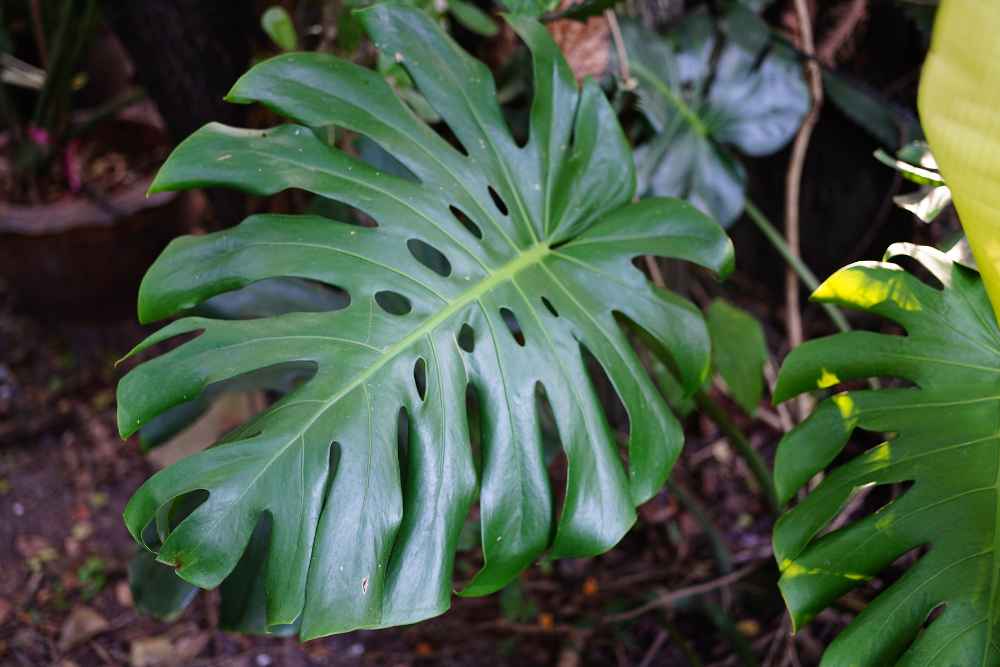
3. Frost Damage
Black leaf patches on Monstera plants can also be caused by frost damage. The reason is that the leaves will require time to heal, and if they are repeatedly harmed by frost over an extended length of time, bacteria will likely begin to occupy them as well.
Ensure your plant is in a protected location to keep it from frost and prevent this from happening again. If the leaves start to turn black, which could be a sign that bacteria have already started attacking them, you could also wish to cover them with straw or another material.
4. Physical Damage
Black leaf spots can appear on Monstera plant leaves that have already sustained physical harm. Both other humans and pets like cats and dogs may be to blame for this. The easiest method to prevent physical damage is to keep your plant in a secure location where it won’t come into contact with these items. Using a repellent to keep these creatures away is something else you should think about.
5. Cold Temperatures
Because there will be less water in the leaves during cold temperatures, Monstera plants may develop black patches on their leaves. When the weather becomes cold, providing your plant with enough warmth is crucial to prevent it from drying out and developing a disease.
7. Mechanical Damage
Black leaf spots are additionally brought on by mechanical harm, such as tearing leaves off of a Monstera plant’s stem or trunk due to severe handling. Because the bacteria will have more access to it and there is now a potential for infection, it may be challenging for a plant to heal on its own after suffering such a wound. Try to seal the wound with a substance that will encourage healing if you accidentally hurt your plant in this way.
8. Dehydration
The emergence of black leaf spots on Monstera plants is another effect of insufficient watering. Dehydration, which contributes to this condition, can also be brought on by both overwatering and underwatering.
The leaves of the monstera plant will begin to turn yellow if it has been sitting in a dry pot for a while with little water inside. This indicates that your plant needs more water, so you should re-water it to avoid the occurrence of black leaf spots.
- 20+ Chic Boho Bedroom Ideas for a Cozy and Stylish Retreat - June 20, 2024
- 12+ Modern Boho Living Room Ideas to Create a Unique Oasis - June 10, 2024
- 10 Stunning Canopy Bed Ideas for a Dreamy Escape - May 16, 2024

